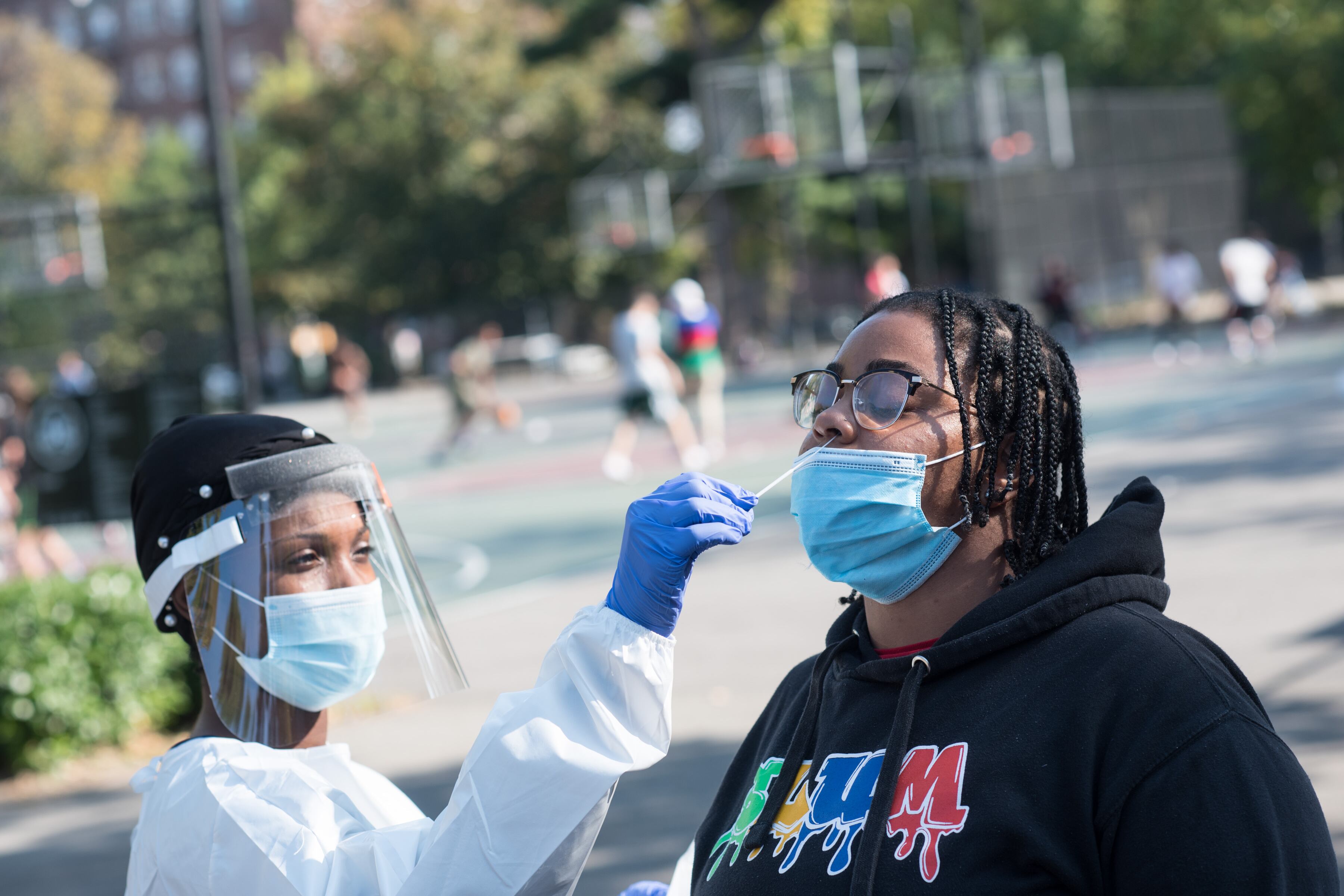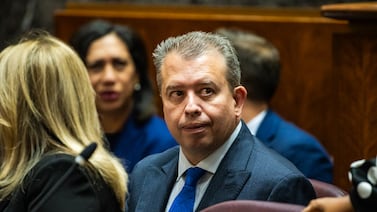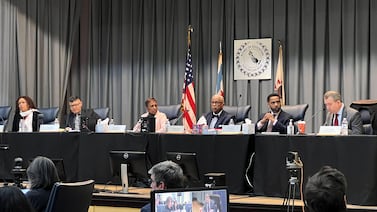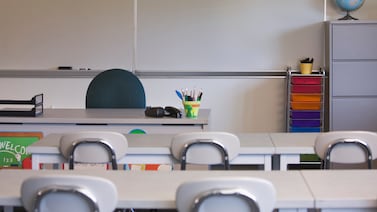As New York City peels back virus safety measures in schools, including mask mandates and social distancing guidelines, one tool remains in place: its in-school COVID testing program that swabs a slice of each school community every week.
But that program comes at a significant cost, roughly $30 million a month on average, Chalkbeat has learned, raising questions among some public health experts about whether it is the best use of resources to protect school communities from the coronavirus.
Some epidemiologists said the current level of surveillance testing can be valuable, with the city aiming to test at least 10% of students at each school every week. As the city rolls back some mitigation measures, and with another virus surge potentially on the horizon, regular testing can provide a check that the virus remains under control in the city’s schools.
But other health experts remain skeptical that the in-school program — which relies on lab-based PCR testing and requires pulling students out of class for up to 30 minutes — is worth the time and money. And the testing program’s main architect acknowledged in an interview with Chalkbeat that it’s worth reassessing it given the substantial cost, availability of vaccines, more contagious variants, and changing value judgements about what degree of risk is acceptable in schools.
“It’s difficult to argue that that’s the best use of money to keep an individual safe,” said Dr. Jay Varma, a top health advisor to former Mayor Bill de Blasio who designed the in-school testing program.
Still, there are other reasons it may be wise to keep the program, including giving educators and parents peace of mind by showing there aren’t a large number of virus cases lurking in classrooms.
“From that perspective,” Varma said, “it may very well be worth the money.”
For now, city officials say they are planning to continue the program and are searching for new funding sources to keep it running this school year as the city exhausts $251 million in federal grant funding that has supported it.
Putting testing to the test
Launched in fall 2020, the in-school testing program is one of the longest-running school safety measures and has been the subject of intense debate, as some educators, parents, and union officials have pushed to increase the scope and frequency of testing throughout the pandemic.
The goal is to help detect virus outbreaks and help measure whether other tools such as masking or ventilation are keeping virus cases low. It was not set up to directly interrupt transmission by removing most people who are contagious from schools. Doing so would require more frequent and widespread testing, Varma said.
With rapid test kits becoming more widely available — and sent home with students if anyone in their class tests positive or if they start showing COVID symptoms — it may be worth dialing back the in-school PCR testing program, some observers said.
Though having some “barometer” for COVID transmission is helpful, said Dr. Benjamin Linas, an epidemiologist at Boston University, “it seems like a really expensive commitment to that concept.”
Linas argues that resources for the city’s in-school PCR testing could be better spent making additional ventilation upgrades or turbocharging the city’s vaccination efforts, as only 53% of the city’s public school students are fully vaccinated. Using rapid tests for students who develop symptoms at school, and their close contacts, could still help detect outbreaks, he said.
Varma indicated the city considered using rapid tests to conduct surveillance testing early on, but said the kits are more cumbersome and take longer to administer in schools compared with quickly swabbing students and sending the results to a lab. Although the PCR test results take longer to return — about 27 hours on average, city officials said — they are also more accurate.
Some public health experts said they would not remove the testing program yet.
“With the BA.2 variant, we’ve only just taken masks off in schools, I think it makes sense just to keep our finger on the pulse,” said Dr. Anna Bershteyn, an assistant professor of population health at the NYU Grossman School of Medicine. “It’s quality assurance.”
Few details on how testing influences policy
The testing program’s value hinges to some degree on how the information is used to inform policy decisions, and city officials have offered few specifics. Even at the height of the omicron wave, city officials largely shied away from using the testing data to close schools, individual classrooms, or conduct investigations into virus transmission, public data show. The city has also backed away from contact tracing when individual cases pop up.
“If there’s no downstream action tied to any of this surveillance, its benefit definitely decreases,” said Dr. Meagan Fitzpatrick, an assistant professor at the University of Maryland School of Medicine who specializes in infectious disease modeling. “But if there are, then there can be benefits.”
Nathaniel Styer, an education department spokesperson, wrote in an email that the testing program “informs all of our COVID decisions.” He said it played a role in the move to end the city’s mask mandate in schools. That change also came after the Centers for Disease Control and Prevention recommended lifting mask mandates in much of the country based on local infection and hospitalization rates.
Even if the program’s impact on policy making remains murky, it may be politically untenable for officials to roll it back. The program enjoys strong support from many educators and the city’s teachers union, which has consistently pushed for more testing throughout the pandemic. (The program allows for up to 10% of school staff to be tested, but educators have said the testing company often declines to test them.)
At the same time, some parents said the program serves as an important accountability tool, allowing them to push for changes to safety measures if virus cases in schools surge.
“In-school testing is a source of data that I wouldn’t want to eliminate just because it’s not clear how the city uses it in decision-making,” wrote Liz Rosenberg, a Brooklyn parent of two who helped launch a dashboard that aggregates school COVID data as an advocacy tool with a group called Parents for Responsive Equitable Safe Schools.
Most students don’t participate
But some experts have questioned how useful the data is. The city only tests students who have consented to participate in the program, and less than half of eligible students in grades 1-12 have done so, according to city data. At roughly 400 city schools, fewer than a third of students have consented to testing. If students who don’t consent are more likely to take fewer COVID precautions in other settings, that could skew the results.
“The presence of testing can be comforting,” said Dr. Susan Hassig, an epidemiologist at Tulane University. “But the presence of PCR testing as it’s currently practiced is probably not that beneficial.”
Varma, the testing program’s designer, said the consent issue is “the biggest weakness of the program,” but city lawyers argued they could not require consent as a condition of attendance, especially without a remote learning option.
“Why is it that lice is something that you can check kids for without parental consent, and dismiss them from school for, but you can’t do it for COVID?” Varma asked. “That baffles me to this day.”
At the beginning of this school year, city officials ran into another implementation problem: One of the four testing companies the city uses to run the school-based program, Fulgent Genetics, was returning a higher share of invalid tests, meaning some test results were not being returned.
About 3% of Fulgent tests were invalid in September, according to a Chalkbeat analysis of city data, far higher than any of the other three companies. The city considers an invalid rate below 1% to be acceptable.
A spokesperson for Fulgent did not return multiple requests for comment. City officials pegged the blame on the type of swab Fulgent was using and said they worked with the company to resolve the issue by retraining staff and changing the swabs it used.
For now, the city has no immediate plans to end the in-school testing program, said Adam Shrier, a spokesperson for the city’s Test and Trace program, which operates it in partnership with the education department.
“We will continue to follow CDC guidance, and direct our program based on science and results, which have ensured schools are the safest place for students in New York City to be,” he said in a statement.
Cam Rodriguez and Thomas Wilburn contributed data analysis




